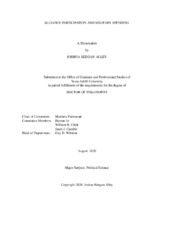| dc.description.abstract | In this dissertation, I examine how military alliance participation impacts military spending. Despite long-standing expectations that alliances affect military spending, we still do not know how. One group of scholars claims that alliance participation often decreases military spending, but another group expects that alliance participation increases military spending. I offer an answer to this longstanding puzzle by explaining when alliance participation increases or decreases military spending. First, I reassess a well known framework for understanding alliances --- the public goods model of alliances. Then, I describe how treaty depth modifies the impact of alliance participation on non-major power military spending. Last, I show that states add depth to alliance treaties to reassure their partners while reducing exposure to entrapment, so democracies often form deep alliances.
Taken together, the argument and evidence in this project indicate that efforts to establish credible alliance commitments shape the bargaining leverage of states, which then determines how alliance participation affects military spending. To start, I examine the public goods model of alliances, and find that differences in economic weight do not lead to differences in military spending. As a result, my argument relies on bargaining between alliance members. Then I show that how alliance participation affects military spending depends on state capability and alliance treaty design. Specifically, treaty depth modifies how non-major power military spending responds to alliance participation. Treaty depth refers to the extent of defense cooperation formalized in the alliance through promises like policy coordination and basing rights. When security-seeking non-major powers join deep alliances they usually decrease military spending, because these treaties are more credible. Joining shallow alliances often increases non-major power military spending due credibility concerns and higher allied leverage. Finally, I show that deep alliances are the result of efforts to increase the credibility of alliance commitments while managing the risk of entrapment. I argue that because treaty depth has limited domestic audience costs but reassures allies, democracies often form deep alliances to increase the credibility of their alliances while managing exposure to entrapment.
To test this argument, I make two innovations in research design. First, I provide a general and reliable test of the public goods theory of alliances, which is missing from previous research. Then, I build a multilevel model to show how alliance characteristics like treaty depth modify the impact of alliance participation on military spending. Multilevel modeling bridges shortcomings in previous research designs by estimating the unique effect of individual alliances. This modeling strategy could be applied by other scholars of international institutions. | en |


